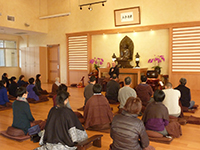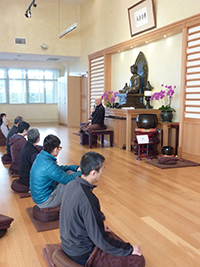I will continue to practice Silent Illumination with confidence

I am very thankful for the opportunity to attend the Silent Illumination 7-day retreat taught by Teacher Zarko Andricevic during November 14 – 21, 2015 at Dharma Drum Vancouver Center. I came to the retreat with a question about which meditation method I should continue to use in my practice. Teacher Zarko’s teaching was clear and easy to follow. His words were precise; he explained the method several times in different ways. He used a few short stories and images to illustrate the idea. After seven days learning and practicing, I have gained a much better understanding of the method and have decided to practice Silent Illumination with confidence from this week. Thanks to Teacher Zarko.
On the first evening, Teacher Zarko started with an introduction of the method - basically samatha and vipasyana were practiced simultaneously. He introduced the teaching of the Sixth Patriarch Huineng of Chan Buddhism, as well as the three doors of liberation. He also reminded us to cherish the opportunity to practice wholeheartedly during the entire retreat.

In the first two days, Teacher Zarko taught us how to relax the body and mind before practicing Silent Illumination. Besides the whole body, the relaxation of eyes and abdomen was also important; the focus was the body weight on the cushion and mat, and then just being aware of sitting there. “Just sitting” was another way to enter Silent Illumination. With an open and relaxed mind, the pattern of our thoughts could be observed: grasping or rejection, past or future. He also talked about having an attitude of compassion in the practice. Sitting in the first two days was painful in my legs and lower back, and I felt each session was too long to sit through.
But, on day three, Teacher Zarko introduced the concept of totality and used a metaphor that pain was like a flying bird in panoramic scenery; therefore don’t only pay attention to the bird and miss the vast landscape. It made perfect sense to me. We also learned walking meditation, which was quite useful for daily practice. In the evening, he explained Master Hongzhi’s poem. It was quite inspirational and also helpful to further understand the method. He also said that whatever situation we encountered, “don’t put yourself in it.” Sitting not only became easier but I also experienced joy this day.

On day four and five, Teacher Zarko talked about diligence and compassion. He said that thinking about impermanence and suffering can help us to overcome procrastination and habitual laziness; compassion for others rather than only for ourselves can motivate us even more to focus our efforts on our practice. On day six, he advised us to have a beginner’s mind. Practice as such can take a long time with lots to learn along the way. He also said that Chan practice was not only in sitting but throughout all the activities in our daily life. The retreat ended with a ceremony of taking refuge and Five Precepts, and transferring merits on day seven.
Besides learning the method of Silent Illumination, we had repentance prostration practice on day four led by Venerable Chang Wu Fashi. It was very important to me. It was a mental cleansing process and I was sincerely contrite for having caused harm to others intentionally or unintentionally. I was also finally able to forgive the individuals who have hurt my feelings. It was an honor to meet Chang Wu Fashi. The way she conducted the retreat and how much she cared for the participants were a good example for me. Thanks to Chang Wu Fashi. (written by Hali Wang)